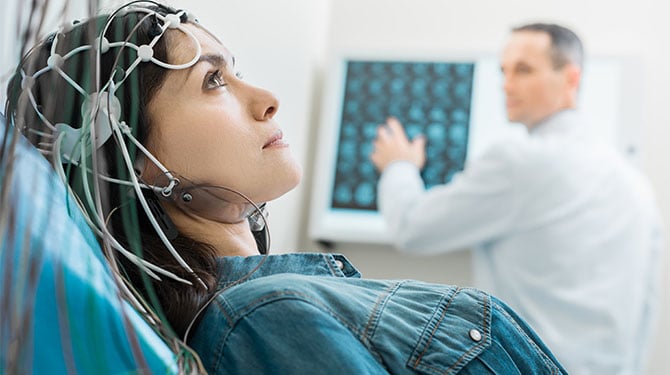
Angelika Klotz
(Holistic therapist)
There are 5 types of brain waves — Alpha, Beta, Gamma, Delta and Theta.
Alpha brain waves are most present when we are awake and relaxed. They can be increased through meditation and mindfulness.
Beta brain waves are involved in logical thinking, conscious thought and concentration.
Gamma brain waves have the highest frequency (fastest brain waves) and are activated when we achieve peak concentration and are engaged in problem solving.
Delta waves, on the other hand, are the slowest type of brain waves and are most pronounced during sleep.
Theta brain waves are connected with deep relaxation and light sleep, which is often a state just before we are to fall asleep.
Now that we know the basics of the 5 types of brain waves, we can explore each of them in more detail.
Brain waves, the human body and nature
Regardless if we want to admit it or not, but our life is determined by rhythms, cycles and seasons. Here, we are not only talking about the larger circle of life of coming into this world and living and dying.
We’re referring to the daily rhythms running our lives; rhythms that we are continuously subjected to — day and night, spring, summer, autumn and winter, high and low tides, emotional patterns, and even relaxation and tension.
Underneath all these obvious patterns are subtle rhythms that most of us are not aware of. Blood pumping throughout the body in circulatory rhythm depends on the tireless work of our heart and its rate of contracting and releasing. Or even the finer breathing patterns that we are taking for granted.
Breathing supports our brain function, digestion, emotional releases, a healthy lymph flow and the very intricate movements of our cranial bones. The brain particularly goes through different rhythms; phases that determine largely the quality of our life, because brain waves support processing of external impulses.
This means that health and disease are accompanied and most probably even preceded by shifts and changes in the natural brain rhythms.
The history and discovery of brain waves
Human brain waves were first recorded by Hans Berger in 1925 and by 1950 EEG detecting machines became very popular.[1]
Beta brain waves vibrate between 13-30 Hz, which is the frequency of our awakened state[2]. Beta determines our ability to concentrate, the level of alertness and the quality of our intellectual activity. Activities like logical thinking, being alarmed or restless and the emotions of fear are a part of the beta rhythm.
If stress is being processed in the body and hormones like adrenaline, norepinephrine and cortisol are being released, beta brain waves will increase as well. In such a scenario, we should practice mindful breathing to reduce the frequency.
RELATED — Introduction to Breathing: Our foundation of health
Another brain wave that is active during the day is the alpha brain wave. Alpha is predominant during our relaxed state, when we close our eyes, during meditation and when our brain takes a rest. It is a pleasant state of rest without feeling sleepy. Alpha brain waves have a frequency between 8-13 Hz.[2]
Artists and creative minds depend largely on the activity of the alpha rhythms because they trigger the creative hemisphere of the brain.
Theta brain waves are most active during light sleep and deep meditation. The frequency is 4-8 Hz. During this phase, we form memories and super-learning is possible due to thinking being switched off, allowing access to the deep layers of subconsciousness. Theta waves also seem to be connected to increased creativity and intuition.
Deep sleep is represented in delta waves (frequency is less than 4 Hz), where the body regenerates.[3] Both theta and delta brain waves are important for a healthy lifestyle. People who regularly skip sleep suffer from decreased rejuvenation and regeneration. A well functioning immune system also depends on deep sleep delta waves.[3]
RELATED — Why we sleep: The role of sleep in our healthy life
The newly discovered gamma brain waves are connected to peak performance, strong focus, higher perceptions and insights.
Gamma waves vibrate on high levels greater than 30 Hz, allowing a superordinate coordination of the brain.
How to control and change our brain waves
A healthy rhythm depends on ideal calibration of activity and rest, concentration and relaxation, wakefulness and sleep. When constant stress runs our life, brain frequencies increase and trigger a constant alert mode.
Over time these changes to the normal rhythms are literally being programmed into a vicious circle that no longer allows a harmonious balance. The brain can lose its original vibrational blueprint.
There are mind machines available (brain machine or light and sound machine) that emit rhythmic sounds, flashing light, electrical or magnetic fields, or a combination of these, to alter the frequency of the user’s brainwaves.[4]
Alteration can be quite abrupt due to the stimulation by different therapeutic methods.
A smoother alternative is the induction of vibrational patterns through the skin. This method has shown great results with learning and concentration difficulties, supporting healing from emotional, hormonal and inflammatory patterns, and more recently – helping people with addictions, weight loss and viral, bacterial or parasite infections.[5]
What’s important to remember is that the brain will take up the rhythmic information that got lost due to stress and will implement what frequencies are missing to support ideal health and well-being.
Meditation practices and energy healing can support this healing mechanism as well.
RELATED — Introduction to Meditation: Ancient medicine for mind and body healing
Wishing you fantastic rhythms for 2021!
Angelika
Angelika has been supporting clients, friends and family members on their journey to health and wellbeing for more than 30 years through healing sessions, education and wellness retreats. After being interested in holistic health care all her life and studying with various Masters in their field in Asia, Germany and Australia, Angelika settled in Auckland 15 years ago where she offers holistic treatments from her studio in Mission Bay.
Her unique and bespoke approach to healing combines ancient techniques such as TCM, Aromatherapy, Colour-Light-Therapy and Reiki with Energy Healing modalities like Kinesiology and BodyTalk. If you are interested to learn more, please visit www.angeliquehealing.co.nz
References
(1) Wikipedia. (n.d.). Hans Berger. https://en.wikipedia.org/wiki/Hans_Berger
(2) Fuess, R. (1994). In Induction Therapy (pp. 17-18). Energetik Verlag.
(3) Mandel, P. (2018). Induction Therapies of Esogetic Medicine. Esogetics GmbH.
(4) Wikipedia. (n.d.). Mind machine. https://en.wikipedia.org/wiki/Mind_machine
(5) US Esogetic Colorpuncture Institute. (n.d.). Synapsis Home 2 Unit. https://colorpuncture.org/products/synapsis-units/synapsis-home-unit/






